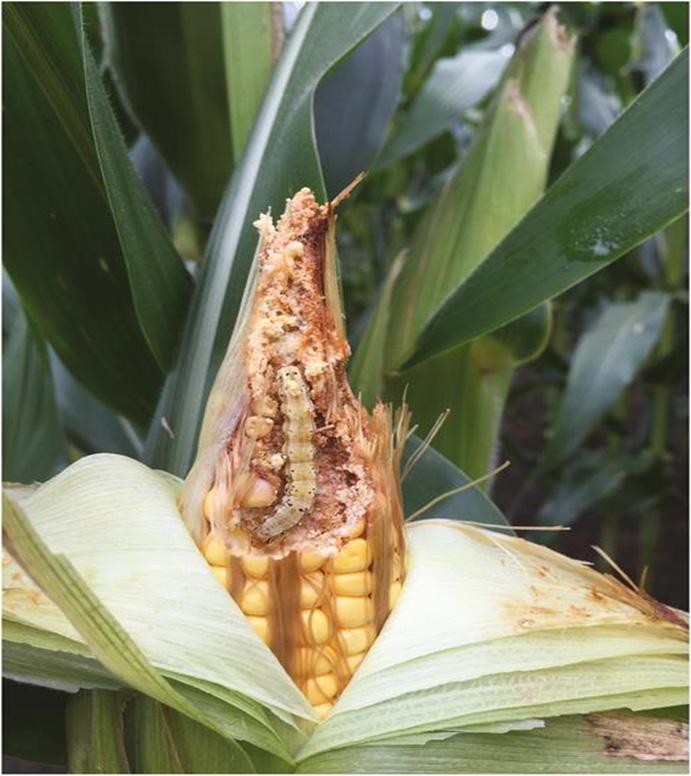Sweet Corn Sentinel Monitoring Network: 2023 Results and Trends
Galen P. Dively, Department of Entomology, University of Maryland
Collaborators: Terry Patton, Kristian Holmstrom, David Owens, Michael Crossley, Helene Doughty, Sean Malone, Tom Kuhar, Daniel Gilrein, Shelby Fleischer, Timothy Elkner, Jared Dyer, Brian Nault, Kelsey Fisher, Jocelyn Smith, Holly Byker, Julien Saquez, Jason Wells, Kelley Tilmon, Chris DiFonzo, Amy Raudenbush, Bill Hutchison, Fei Yang, Robert Wright, Craig Abel, Decker Ashley Lynn, Christian Krupke, Nicholas Seiter, Bradley McManus, Anthony Zukoff, Brian McCornack, Dominic Reisig, Steven Roberson, Anders Huseth, Francis Reayjones, Tom Bilbo, Dave Buntin, Katelyn Kesheimer, Whitney Crow, Huang Fangneng, Pat Porter, Dalton Ludwick, Yves Carriere, Kelly Hamby
Starting in 2017, the sweet corn sentinel monitoring network has been tracking changes in corn earworm (CEW) susceptibility to Cry and Vip3A toxins expressed in Bt corn and cotton. Each year, Syngenta and Bayer-Seminis provided sweet corn seed that is repackaged and distributed to volunteer collaborators to establish sentinel plantings of Bt hybrids (expressing Cry1Ab, Cry1A.105+Cry2Ab2, and Cry1Ab and Vip3A) planted side by side with non-Bt isolines. All collaborators used the same sampling and data collection protocol to generate metrics showing differences in control efficacy between Bt and non-Bt plots, expressed as the percentage of ears damaged, density of surviving larvae per ear, and the amount of kernel area consumed per ear. To estimate the range of allele frequencies for CEW resistance to each Bt toxin, the phenotypic frequency of resistance (PFR) was calculated as the ratio of larval density in Bt ears relative to the density in non-Bt ears. Using this approach, a significant reduction in control efficacy coupled with an increased PFR was viewed as a genetically based change in CEW susceptibility and confirmation of field-evolved resistance.

The 2023 network involved 62 sentinel plantings in 25 states (TX, LA, AL, MS, AZ, GA, SC, NC, VA, MD, DE, PA, NJ, NY, CT, OH, IN, IA, IL, NE, SD, KS, WI, MN, MI) and 4 Canadian provinces (ON, QC, NS, NB). Collaborators in 12 states and ON established multiple plantings at different times and/or locations. Most plantings included five sweet corn hybrids: Attribute ‘BC0805’ expressing Cry1Ab, Attribute II ‘Remedy’ expressing Cry1Ab and Vip3A, and their near non-Bt isoline ‘Providence’ (Syngenta Seeds); and Performance Series ‘Obsession II’ expressing Cry1A.105+Cry2Ab2, and its non-Bt isoline ‘Obsession I’ (Bayer-Seminis Seeds). In addition, 11 sentinel locations established plots of the Milky Way hybrid (Syngenta Seeds) expressing Cry1Ab and Vip3A. Altogether, a total of 29,821 ears were examined to record the location and amount of kernel consumption, larval density by instar, and presence of exit holes. Complete data sets of 56 sentinel plantings were submitted and analyzed, whereas 5 plantings were not sampled due to poor plant growth and ear formation. High CEW infestations caused kernel damage to >70% of the non-Bt ears in 36 plantings. Summed over all sentinel plantings, 76.3% of the non-Bt ears were damaged, with 1.28 larvae and 6.41 cm2 of kernel consumption per damaged ear. In comparison, the percentage of CEW-damaged ears expressing Cry1Ab, Cry1A.105+Cry2Ab2, and Cry1Ab+Vip3A averaged 70.7%, 64.9% and 0.61%, respectively. The number of larvae and kernel consumption averaged 1.27 and 5.28 cm2 in damaged Cry1Ab ears, and 1.13 and 4.77 cm2 in damaged Cry1A.105+Cry2Ab2 ears, respectively. Collaborators sampled a total of 12,247 Cry1Ab+Vip3A ears to detect changes in CEW susceptibility to the Vip3A toxin. Only 17 of the 69 Remedy and Milky Way plots had live larvae feeding at the ear tip, which were mainly 2th and 3rd instars, averaging 0.004 larvae per ear and usually associated with < 1 cm2 of kernel injury. Forty-two of the 68 Remedy and Milky Way plots were uninfested and undamaged.
The network also monitored susceptibility changes and regional differences in European corn borer (ECB), fall armyworm (FAW), and western bean cutworm (WBC) populations. Ten sentinel locations recorded FAW ear damage in non-Bt plots, ranging from 2-24%. Four locations (NE, ON, NB, and QC) recorded WBC damage in non-Bt ears (ranging from 15- 32%), BC0805 ears (ranging from 4-25%), and Obsession II ears (ranging from 1-60%). Twelve trials recorded ECB ear damage in non-Bt plots (ranging from 2-30%), primarily at locations with low adoption of Bt corn. Most noteworthy, the CT sentinel planting reported the first occurrence of live ECB larvae and tunneling damage in plants of Cry-expressing sweet corn in the US. The following summarizes the ECB infestations in each sweet corn hybrid: 20.5% of the Obsession II (Cry1A.105+Cry2Ab2) plants had either shank and/or stalk tunneling, with 12.4 live 5th instar ECB per 100 plants; 33.0% of the Obsession I (non-Bt) plants had either shank and/or stalk tunneling, with 38 live 5th
instar ECB per 100 plants; 17.0% of the Providence (non-Bt) plants with either shank and/or stalk tunneling, with 17 live 5th instar ECB per 100 plants; 34.5% of the Remedy (Cry1Ab + Vip3A) plants with either shank and/or stalk tunneling, with 15 live 5th instar ECB per 100 plants; and 13% of the BC0805 (Cry1Ab) plants with either shank and/or stalk tunneling, with 3 live 5th instar ECB per 100 plants. Follow-up sampling of all ears at the CT sentinel location was conducted to collect surviving larvae for laboratory analysis.
For CEW estimates of the PFR, it was assumed that any live 2th thru 6th CEW larvae that survived to cause kernel damage in a Bt ear indicates some level of resistance to the expressed toxins, that could result in mature larvae surviving to contribute resistance alleles in the next generation. Not all data sets were used to calculate PFRs for each sentinel planting, depending on whether all five hybrids were planted. Furthermore, only data from plantings reporting >50% damaged ears and infested with >50% 4th, 5th and 6th instars were used to calculate PFRs. Forty-five of the 56 sentinel plantings satisfied these criteria for one or both Cry toxins; the remaining plantings either had very low CEW infestations or the timing of ear sampling was too early to record the number of surviving late instars per ear. Forty-nine trials satisfied the selection criteria for the Cry1Ab+Vip3A toxins. The following summarizes the PFRs for each individual or pyramided Bt toxin(s), in comparison with previous sentinel monitoring results.
Cry1Ab (BC0805 vs Providence): The level of CEW phenotypic resistance has significantly increased, since Cry1Ab sweet corn was commercially introduced in 1996. PFRs estimated from sentinel plantings each year in Maryland averaged 0.28 during 1996-2003 and 0.64 during 2004-2016. Based on results of the expanded monitoring network, PFRs averaged 0.99 in 2017, 0.85 in 2018, 0.76 in 2019, 0.95 in 2020, 1.06 in 2021, 1.07 in 2022, and 1.09 in 2023. The percentage of damaged ears and kernel consumption per Bt ear, along with larval development delays, remained about the same during the last three years. However, the most noteworthy finding is that 22 of the 35 BC0805 plantings that satisfied the selection criteria in 2023 reported higher CEW densities per Cry1AB ear compared to densities per non-Bt ear (PFR>1). The difference in larval densities is the result of behavioral changes in sublethally intoxicated larvae. In a non-Bt ear, many early instar CEW can freely feed together initially, but then become cannibalistic once they reach the 4th instar stage.
Cry1A.105+Cry2Ab2 (Obsession II vs Obsession I): Phenotypic frequencies have steadily increased since 2010, averaging 0.19 during 2010-2013 and 0.41 during 2014-2016. Sentinel network results continue to show some evidence of further resistance development to the dual Cry toxins, with PFRs averaging 0.67 in 2017, 0.93 in 2018, 0.70 in 2019, 0.89 in 2020, 0.95 in 2021, and 0.92 in 2022. In 2023, the estimated PFR was 0.85, based on 31 of the 47 sentinel plantings of Obsession II vs Obsession I that satisfied the selection criteria. Eleven sentinel locations reported higher CEW densities in Obsession II, resulting in PFRs ≥ 1. However, over the last three years, there has been no consistent increase in phenotypic frequency, kernel consumption, or percentage of older instars surviving Cry1A.105+Cry2Ab2 ears. Pyramiding with other Bt toxins, particularly Vip3A, in field corn and cotton may have reduced the selection pressure on these two Cry toxins, thus resulting in a slower rate of resistance development.
Cry1Ab and Vip3A (Remedy/Milky Way vs Providence): Previous studies in MD and MN during 2013-2016 reported virtually no CEW survival or damage in Vip3A-expressing sweet corn. However, sentinel monitoring starting in 2017 began to report larval survival with expansion of the network to more southern locations. During 2017-2019, 0.72% of the 9,369 Vip3A ears sampled had minor tip damage associated primarily with 2thand 3rd instars. Furthermore, results by year show a small but noticeable increase in the number and age of surviving larvae. Of the 20,312 ears sampled during 2020-2022, 156 ears (0.77%) had minor damage (<0.5 cm2, primarily on the tip), but only 25 of these ears (0.12%) were infested with a total of 82 live larvae (78% early instars). Trials reporting most of the ear damage and older larvae in Vip3A ears were southern locations (TX, LA, MS, AL, NC). However, not all of these damaged ears were tested for Vip3A expression, so there is the possibility that some ears resulted from contaminated non-Bt or Cry-expressing seed. Nevertheless, assuming all ears with live larvae expressed Vip3A, the overall PFR estimated from trials conducted during 2020-2022 was 0.0044.
In 2023, additional sentinel plots were planted with the Vip3A expressing Milky Way sweet corn, and most collaborators sampled higher number of Remedy and Milky Way ears to increase the chances of detecting early signs of resistance to the Vip3A toxin. Twelve of the 49 sentinel plantings that satisfied the selection criteria were infested with a few surviving CEW, with PFRs for Vip3A resistance ranging from 0.003 to 0.070. In contrast with previous sentinel results, sentinel locations in IL, NE, IA, VA and NC had the highest PFRs (≥0.020) showing evidence of Vip3A resistant alleles, compared to southern locations in TX, AL and LA reporting PFRs ≤0.007. The higher PFRs in the more northern sentinel locations may be the result of migrate CEW moths that were previously subjected to a generation of Vip3A selection pressure in the south. In any case, these results continue to indicate early signs of CEW resistance to Vip3A, yet there was no evidence of any increase in 2023 compared to the 2020-2022 results. Furthermore, the Vip3A expressing sweet corn still provided excellent ear protection against CEW in all sentinel plantings.
Back to LESREC Roots in Research
